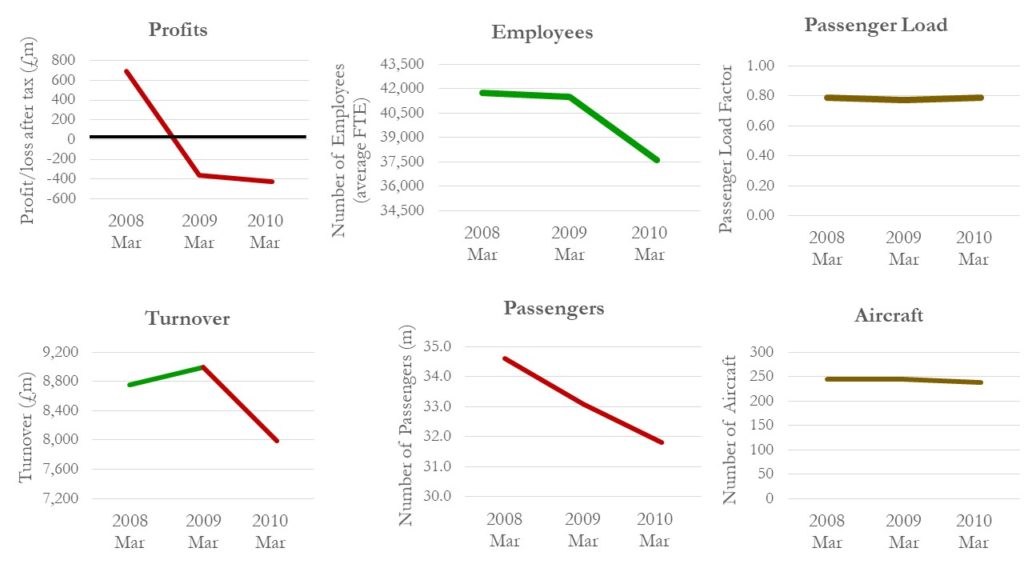- Read the scenario description, goal, and learning objectives below.
- Notice that under “Simulation”, there is an image of each executive team member, with information next to them that can be accessed through reading text or listening to an audio file. For each member of the executive team, read or listen to their thoughts and dialogue in the meeting about the scenario.
- After learning about each executive team member’s thoughts and dialogue, see if you can answer the essay question at the bottom of the page.
- After answering the essay question, use the menu at the left to navigate to Scenario #3.
This scenario centers around an Executive Team meeting that takes place in June 2010. At the beginning of the meeting, Ms. Saver puts a slide up for everyone to see. It shows line graphs of the changes in metrics at British Airways from 2008 until the time of the meeting. See them depicted in the image below.

Unfortunately, many show negative trends. Ms. Saver is particularly exercised about the fact that the airline appears to be “under water” – the profits are negative, and have been since 2009! Ms. Saver says that “desperate times call for desperate measures”. She passes out a handout to all the attendees explaining the 8 elements of TQM she found on the ASQ web site.
Ms. Saver wants the group to discuss the following:
- Discuss the TQM elements and choose up to three priority elements to emphasize in their systemic solution, then
- Brainstorm solutions based on emphasizing those elements that would rescue not only profit, but the other metrics showing that the health of the business is either stagnant or decreasing.
The goal of this scenario is to use TQM elements to guide the development of a management solution aimed at turning around profits and improving other benchmarks and metrics.
At the end of this scenario, the learner should be able to:
- Describe one TQM element that could be emphasized in a company trying to turnaround its profit, and state your rationale,
- Describe one TQM element that could be de-emphasized in a company trying to turnaround its profit, and state your rationale, and
- Describe one TQM element that could be emphasized in a company trying to improve multiple benchmarks, and state which benchmarks you think would be positively impacted and why.
Human Relations Department

Chief of Staff, Human Relations
Mr. Hari/Chief of Staff
Thoughts
Wow, these numbers don’t look very good. It kind of shocks me, because Dr. Tinker has really the best engineering shop in the industry. But now that I’m reminded of these TQM elements, I’m thinking maybe we became too process-centered. We have to focus on our processes, but honestly, I think we’ve taken our eye off of our employees. So many of my employees want to excel, but they don’t really know what their boss wants them to do that’s above and beyond expectations. This means they have trouble developing themselves and their careers – maybe even thinking of management and promotion. They want to do more, but they feel stuck.
Statement in Meeting
“Hey everyone, I just want to say thank you, Ms. Saver, for those numbers, but I know we are all groaning because they do not look very good. But I have some news that might actually be good for us, and that is that my employees are really committed to BA and want to do more. I have people working on the runway, in ticketing and reservations, in customer service, everyone coming to me saying they want to be a bigger part of our amazing organization. So maybe we should take a second look at the element of “total employee involvement” and see if we can find a way to emphasize that.”
Finance Department

Chief of Finance, Finance Department
Ms. Saver/Chief of Finance
Thoughts
I admit I don’t like these numbers, and I haven’t liked these trends for a long time, but I really can’t figure out what the problem is. Why is it that we are being more efficient with our employees, and maintaining a stable passenger load and number of aircraft, but at the same time, the number of passengers is going down, and our profits are under water? Maybe we are just getting too disconnected. Maybe we actually need more aircraft and should be increasing our passenger load. And, maybe we even need more employees – not fewer – and just do not realize it. Maybe this is a very big picture, systems problem.
Statement in Meeting
“I love working on this team with you all, and we have a great relationship, but I’m wondering if we are not doing a good job of integrating all of BA the way we integrate with each other when we attend this meeting. I am thinking of the TQM element of the “integrated system”. I colored the employee chart green because I thought it was good that our number of employees was going down. But now that I hear what Mr. Hari says, I think maybe that is not good. Maybe they are leaving because we are not developing them as well. And why is that happening? We have a big system, and it ultimately saves money to hire people from within the system and build them up. Perhaps our goals for the next year should focus on more tightly integrating our system.”
Operations Department

Chief of Operations, Operations Department
Ms. Logistics/Chief of Operations
Thoughts
What stands out to me is that big red line heading down representing passengers. Those are our customers! Why is it so steep? It’s almost like they are jumping off the planes themselves! I can’t help but think it has something to do with our customer service, but it’s not fair to place that on Lady Goodflight’s department with no data. I also worry that in our haste to reduce the number of employees, we might have done away with employees we needed for our profits – like the people in marketing and sales. But the thing is I don’t know, so I don’t feel comfortable telling my coworkers that that’s what the problem is.
Statement in Meeting
“Everyone, I have thought really hard about this, and I have decided that I don’t know why our profits are going down. But I could know – and we all could know if we gathered the facts. So I suggest that to solve this problem, we emphasize the element “fact-based decision-making”. This means that we could do market research directly with customers to figure out why we’re having fewer passengers. We are reducing the number of employees, and we could find out what positions were actually phased out. Maybe they are positions we need. I’ll bet if we focus on gathering facts, once we got our facts, we all could easily decide on a pathway forward.”
Engineering Department

Chief of Engineering, Engineering Department
Dr. Tinker/Chief of Engineering
Thoughts
Well, I’m just a dumb engineer here. I’d avoid being a passenger myself if I didn’t have to go to meetings out-of-town! I’d be happy to just work in the shop all day. So it’s hard for me to get inside the heads of these passengers who are not buying tickets at the rate they apparently used to. But actually, maybe that’s the problem. My employees in Engineering are a lot like me – they don’t really think much about air travel. They don’t really know our customers. And if we want to increase our profits, shouldn’t we focus on our so-called customers? Shouldn’t we try to please them, or cater to them, or in some way make it so all the departments are trying to attract them?
Statement in Meeting
“Hey everyone, this may sound funny coming from me, since I don’t deal directly with customers very often, but I think the element we should select for priority is “customer-focused”. I realize I’m not a “customer expert”, but please hear me out. Actually, that’s my point! It’s our customers who are responsible for our profits, and I don’t know anything about them, and neither do my staff, for the most part. And maybe Ms. Saver or Ms. Logistics – you might be in the same boat with me. Maybe we all need to have Mr. Hari and Lady Goodflight help us get into the minds of the customer better. What do you all think of that?”
Customer Service Department

Chief of Customer Service, Customer Service Department
Lady Goodflight/Chief of Customer Service
Thoughts
I am such a positive and optimistic person, but I feel today I only have bad news. For the last year, I have been squawking and squawking about how customers are getting lost in the system. They have trouble buying tickets online and then revising them, or integrating in-person sales with online sales. And it’s a nightmare when a flight is canceled and customers need to be made whole. We lose a lot of money because our systems are so disconnected, and we also anger the customers while this happens. I have not been successful at convincing the group to look at this – but maybe now, I will be heard differently.
Statement in Meeting
“Friends, I hate to say it, but I think this plunging profit is the result of the disconnected experience our customers have been having that I have reported to you many times in these meetings. Granted, each time it is something different, but I think it is adding up to a disjointed – and disappointing – customer experience. So for a focus, I think we should choose two of these elements to emphasize: “Process-centered” and “communications”. I think we should dissect customer service processes, and once we get all our systems aligned into the best process, we should focus on communicating these improvements to the customer. What do you say? How does that sound? It might be difficult, but if we all work together, we will all own the success together!”
FSU Students: Please submit your essay on Blackboard per your professor’s instructions.
In 2010, although British Airways attributed their success at increasing inventory turnover and reducing number of employees as resulting from their TQM, unfortunately, they were suffering profit losses. Reflecting on how British Airways used TQM in the past, how might you shift the focus of the TQM if you were leading British Airways in 2010?
State one (1) TQM element you would de-emphasize, and one (1) TQM element you would emphasize, and explain your rationale. Based on your choice of a priority TQM element, suggest a management intervention that you think would bring a turnaround in profit and emphasize the TQM element you stated. What metrics (aside from profit) would show you were successful at implementing the new TQM goals? Table 1 of the case study can provide ideas for metrics, but you can come up with your own, as well – so long as they are measurable, and you can explain how they would be measured.
| Component | Maximum Points |
| Stated at least one (1) TQM element to emphasize, and at least one (1) to de-emphasize. | 2 |
| Clearly explained the rationale for emphasizing and de-emphasizing stated TQM elements. | 2 |
| Proposed a reasonable management intervention that could improve profits based on emphasizing priority TQM element. | 1 |
| Clearly stated metrics that could be used to benchmark success, and if they are benchmarks not already in the case study, clearly stated how they would be measured. | 1 |
| 200 to 300 words | 1 |
| Clear, cohesive writing with proper grammar. | 1 |
| Appears to have integrated the concepts of applied TQM in answer. | 1 |
| Total | 9 |


